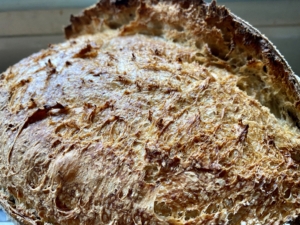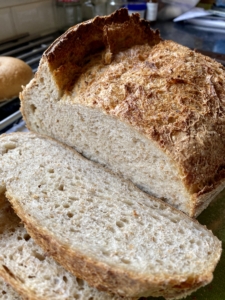Country
Equipment Needed
Kitchen scales
Large mixing bowl
Clean plastic bag
Banneton 21cm diameter
Bread lame (or razor blade)
Enamel roasting tin with lid
Baking paper (please don’t use greasproof paper as it’s not none stick)
Oven gloves
Cooling rack
Ingredients Needed
Starter, fed and ready to use – see my pages on starters and starter care
Strong wholemeal bread flour – I like to use Marriages Canadian Stoneground flour
Strong white bread flour, such as Marriages Organic Strong White
A good quality Rye flour
Water – either boiled and cooled to room temp, or filtered
Salt – I prefer to use sea salt and not table salt
Rice flour – used for dusting bannetons
The Recipe
Country Farmhouse Sourdough
75g ripe and ready starter (I use my all white starter for this recipe)
340g lukewarm water plus 10g Olive oil
400g white flour
100g whole meal flour
20g rye flour
1.5 tsp salt
Extra flour for dusting and rice flour for dusting the banneton
Country Farmhouse Sourdough
Country Farmhouse Sourdough
This recipe will make one loaf of Country Farmhouse sourdough and includes approximate timings
Start your dough building mid to late afternoon. I start around 5pm.
Mix 75g of ripe and ready starter with 340g of lukewarm water plus the 10g Olive oil, and stir them together so the starter is completely dissolved.
Add all the flours and 1.5 teaspoon of salt.
Mix it all together loosely. It’ll probably be a bit lumpy and bumpy, just make sure all the flour and water is mixed.
As tempting as it seems, don’t start to knead this dough. As the recipe title implies, this is a no knead country farmhouse sourdough bread.
Cover the bowl with cling film and leave to rest on the side for an hour.
HINT:
If your kitchen isn’t very warm, like mine, then just set your oven light to be on. That usually creates sufficient warmth in a small space for the dough to rest and rise.
After an hour, lift and fold the dough and bring it into a smooth ball of dough. Literally pick up a handful of dough from one side of the bowl, lift it and fold it over the rest of the dough to the other side of the bowl; you don’t need to pull it tight. Then turn the bowl and repeat the process, do it about 20-25 times maximum, until its a smooth ball.
Cover the bowl again and leave it out on the kitchen counter (or pop it back in your warm snug oven). Perform the “stretch and fold” 2 to 4 more times over the next two hours. I normally do this every half an hour. You can now leave the dough in it’s warm space, covered, to prove. This is often termed as the “bulk fermentation” period.
At about 10pm
Prepare your banneton by liberally dusting it with rice flour. It needs to be really well floured, all the way up the sides, so that the dough doesn’t stick. Normal flour or bread flour draws moisture out of the dough and then in turn sticks to the banneton. Rice flour is excellent at preventing sticking as it doesn’t absorb the moisture from the dough.
Perform another round of stretch and folds with the dough, 2 or 3 will do, and bring it into a loose ball again. Don’t be too heavy handed and don’t handle the dough too roughly, this is to preserve the gluten structure and air pockets in the dough.
Place the ball of dough, smooth side down into the banneton.
Pop the whole banneton into a plastic bag, and put it in the fridge for minimum 1 hour, but anywhere up to about 12 hours. This is the “final proof”.
When you’re ready to bake
Pre-heat the oven to 220C and take the dough out of the fridge whilst the oven comes to temperature.
Once the oven is up to temperature, line your enamel roaster with a sheet of parchment baking paper.
Place the tin over the top of the banneton, then invert it/turn it all over together to turn the dough into the pot.
This loaf will need to be baked for 50 minutes in total, 45 minutes covered plus 5 minutes uncovered.
Flour salt and water
Sourdough Bread Artisan Bread Bakery Blog
Made with the simple basic ingredients of flour, water and salt; there are three distinct stages to making a sourdough loaf (1) The Starter (2) The Ferment and (3) The Dough itself.
www.sourdoughbread.co.uk
A little bit about this site
I want to offer and share information, tips, techniques, recipes and tools for the home baker, with an above average interest in the art of sourdough bread making.



